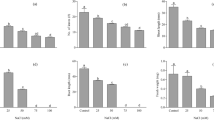Summary
An extract from 6000 dark-grown Phaseolus coccineus seedlings was purified by countercurrent distribution and G-10 Sephadex followed by gradient elution from a silicic acid partition column with increasing amounts of ethyl actetate in n-hexane. 25 fractions were collected and tested with the barley-aleurone, ‘Tan-ginbozu’ dwarf-rice, lettuce, cucumber, dwarf-pea, d-1, d-2, d-3 and d-5 maize, oat first-internode, and sugarcane-spindle bioassays. Major gibberellin (GA)-like activity was detected in fractions 4 (500μg GA3-equivalents) and 12–13 (270 μg GA3-equivalents) with smaller amounts in fractions 6, 8–9, 15–16, 18, 20, 23 and 25. The extracts were also applied to AMO-1618=dwarfed Ph.-coccineus seedlings. Fractions 4, 8 and 12 promoted the growth of both light- and dark-grown seedlings. GA1, GA3, GA4 and GA8 were active in the Phaseolus bioassay but GA8-glucoside was inactive.
The biological and chromatographic properties of fractions 4, 8–9 and 12–13 correspond with those of GA4, GA19 and GA1. The identity of GA4 in fraction 4 was conclusively established by combined gas chromatography-mass spectrometry (GC-MS) of the methyl ester and the trimethylsilyl ether of the methyl ester. Gasliquid-chromatography peaks corresponding to these derivatives of GA19 and GA1 were detected on QF-1 and SE-33 columns but their intensities were too weak to permit conclusive identification by GC-MS.
Similar content being viewed by others
References
Binks, R., MacMillan, J., Pryce, R. J.: Plant hormones. VIII. Combined gas chromatography-mass spectrometry of gibberellins A1 to A24 and their trimethylsilyl ethers. Phytochem. 8, 271–284 (1969).
Brian, P. W., Hemming, H. G., Lowe, D.: Comparative potency of nine gibberellins. Ann. Bot. 28, 369–389 (1964).
Cavell, B. D., MacMillan, J., Pryce, R. J., Sheppard, A. C.: Plant hormones-V. Thin-layer and gas-liquid chromatography of the gibberellins; direct identification of the gibberellins in a crude plant extract by gas-liquid chromatography. Phytochem. 6, 867–874 (1967).
Crozier, A., Aoki, H., Pharis, R. P.: Efficiency of countercurrent distribution, sephadex G-10 and silicic acid column chromatography in the purification and separation of gibberellin-like substances from plant tissue. J. exp. Bot. 20, 786–795 (1969).
— Audus, L. J.: Biological and chromatographic properties of two gibberellin-like compounds from etiolated Phaseolus multiflorus seedlings. Phytochem. 7, 1923–1931 (1968).
—— Distribution of gibberellin-like substances in light- and dark-grown seedlings of Phaseolus multiflorus. Planta (Berl.) 83, 207–217 (1968a).
— Kuo, C. C., Durley, R. C., Pharis, R. P.: The biological activities of 26 gibberellins in nine plant bioassays. Canad. J. Bot. 48, 867–877 (1970).
Durley, R. C.: Chemistry and biochemistry of plant gibberellins; quinones from Aspergillus melleus. Doct. dissect. Univ. of Bristol, England (1968).
Durley, R. C. MacMillan, J., Pryce, R. J.: Investigation of gibberellins and other growth substances in the seed of Phaseolus multiflorus and Phaseolus vulgaris by gas chromatography and by gas chromatography-mass spectrometry. Phytochem. (1971), in press.
jones, D. F.: Examination of the gibberellins of Zea mays and Phaseolus multiflorus using thin layer chromatography. Nature (Lond.) 202, 1309–1310 (1964).
Jones, R. L.: Aqueous extraction of gibberellins from peas. Planta (Berl.) 81, 97–105 (1968).
— Varner, J. E.: The bioassay of gibberellins. Planta (Berl.) 72, 155–161 (1967).
Kende, H., Lang, A.: Gibberellins and light inhibition of stem growth in peas. Plant Physiol. 39, 435–440 (1964).
Köhler, D., Lang, A.: Evidence for substances in higher plants interfering with response of dwarf peas to gibberellins. Plant Physiol. 38, 555–560 (1963).
MacMillan, J., Pryce, R. J.: Recent studies of endogenous plant growth substances using combined gas chromatography-mass spectrometry. In: Plant growth regulators. Soc. Chem. Ind., Monogr. No 31, p. 36–50 (1968).
Most, B. H.: A sugar spindle bioassay for gibberellins and its use in detecting diffusible gibberellins from sugarcane. In: Biochemistry and physiology of plant growth regulators (F. Wightman and G. Setterfield, eds.) p. 1619–1633. Ottawa: Runge Press.
Murakami, Y.: A new rice seedling bioassay for gibberellins, “Microdrop method” and its use for testing extracts of rice and morning glory. Bot. Mag. (Tokyo) 81, 33–43 (1968).
Musgrave, A., Kende, H.: Radioactive gibberellin A5 and its metabolism in dwarf pea. Plant Physiol. 45, 56–61 (1970).
Nitsch, J. P., Nitsch, C.: Studies of the growth of coleoptile and first internode sections. A new, sensitive, straight growth test for auxins. Plant Physiol. 31, 94–111 (1956).
Nitsch, J. P., Nitsch, C.: Activités comparées de neuf gibberellines sur trois tests biologiques. Ann. Physiol. vég. 4, 85–97 (1962).
Phinney, B. O., West, C. A.: Gibberellins and plant growth. Handbuch der Pflanzenphysiologie (W. Ruhland, ed.), vol. 14, p. 1184–1227. Berlin-Göttingen-Heidelberg: Springer 1961.
Powell, L. E., Tautvydas, K. J.: Chromatography of gibberellins on silica gel partition columns. Nature (Lond.) 213, 292–293 (1967).
Sembdner, G., Weiland, J., Aurich, O., Schreiber, K.: Isolation structure and metabolism of a gibberellin glucoside. In: Plant growth regulators. Soc. Chem. Ind. Monogr. No 31, p. 70–86 (1968).
Skene, K. G. M.: The gibberellins of developing bean seeds. J. exp. Bot. 21, 236–246 (1970).
Zeevaart, J. A. D.: Reduction in gibberellin content of Pharbitis seeds by CCC and after effects in the progeny. Plant Physiol. 51, 856–862 (1966).
Author information
Authors and Affiliations
Additional information
Supported by an S.R.C. Studentship
Supported by a NATO Grant.
Supported by NRC Grant A-5727.
Rights and permissions
About this article
Cite this article
Crozier, A., Bowen, D.H., MacMillan, J. et al. Characterization of gibberellins from dark-grown Phaseolus coccineus seedlings by gas-liquid chromatography and combined gas chromatography-mass spectrometry. Planta 97, 142–154 (1971). https://doi.org/10.1007/BF00386762
Received:
Issue Date:
DOI: https://doi.org/10.1007/BF00386762




